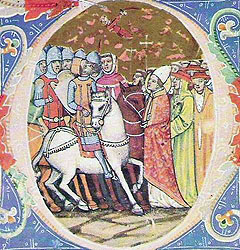
This is a miniature of Attila the Hun, aka the Scourge of God (406-553), meeting Pope Leo the Great (p. 440-461) in 452. The picture is from the Chronicon Pictum, a medieval illustrated chronicle dating from fourteenth-century Hungary.
For a maximum of 25 points extra credit, as head of the city of Rome, besieged by the barbarian Huns, in a short paper (one or two pages) write a description, as detailed as possible, of your dinner with Attila the Hun as you try to negotiate a solution that will save the city from being pillaged.
An interpretative account of Diner with Attila the Hun by Rex Bradshaw (*.pdf format)

Rex explained how he went about creating his answer to this assignment.
When I first read the assignment, my initial reaction was "What? The Huns never besieged Rome, did they?" Looking into it, I found that I was correct. Therefore I assumed that the assignment wanted a recreated, fictional tale, where this had actually taken place. Now, the Huns did come close to Rome, all the way to the Po River, but they were stopped when the Pope Leo the Great convinced Attila to turn elsewhere with his horde in 452, thus averting another sack (unfortunately not for very long as the Vandals sacked Rome only a few years later). Moreover, Flavius Aetius (c396-454) was a cunning general, which I did not want as a protagonist. Therefore I inserted two elements to the historical tale: Aetius was killed at the Battle of Chalons, which was historically a great victory against the Huns, and the Pope was convinced not to risk his life for the city of Rome. The reasoning for the first rested on the failure of negotiations by Marcus Maecilius, commonly known as Avitus, with the Goths. In the historical record, Avitus met with the Visigoths and convinced them to side with the Romans in the war against the Huns, which was no doubt a decisive factor in the Battle of Chalons. Without Gothic help, the Romans might well have been routed, and it is possible that Aлtius would be killed.
The next question that I had was who would be magister militum (a high ranking military commander) after the death of Aetius. At first I was going to choose the son of Aetius, Gaudentius. But he has only the smallest of roles in the histories, mostly through his father. Therefore I turned to Avitus. He was the natural choice; the usurper Petronius Maximus appointed him magister militum after the assassination of Aetius at the hands of Emperor Valentinian himself. Avitus had strong connections with the Goths and enjoyed substantial power. Maximus was killed soon after so the position really didn't do much for him or anyone else; Avitus was made Emperor. Nevertheless it was this appointment which made me decide to make Avitus the magister militum during the Hun invasion of Italy. Avitus was disliked by his people during his short years as Emperor, despite great success against the Vandals. While not a genius like Aetius, he was a warrior, which might explain why he might convince the Pope not to seek reconciliation between Roman and Hun. Instead he might go himself, when Rome itself was under siege. Thus the story was set up.
Secondly, there came the issue of the feast itself. Fortunately, there was a historical account available at my fingertips: that of one Thracian named Priscus, who visited the court of Attila with the ambassador of Theodosius II in 448--just three years before the setting of my story--and described Attila's court in some detail. From this rich account I learned about the hospitality and generosity of Attila. Although my account is not nearly as vivid or as detailed as that of Priscus, I believe I captured the general spirit of the place. I took my description of Attila from Iordanes.
Then I wrote the account. I could have expanded the whole thing to ten pages at least, but I tried to keep it short. I certainly would have liked to lengthen the account of the diplomacy, which turned out (in my opinion) almost ridiculously short. Part of what I then had to estimate was the tribute that Attila would demand. I glanced at past tributes Rome had paid or Attila had demanded. Taking the amount in pounds, I converted it to minae, and thus had my estimate. When I had finished the account, I researched how a Roman letter was typically formatted. The Roman salutation at the top was a common one, as I understand; S.V.B.E.E.V. being a common abbreviation for, as I recall, "si vales, bene est, ego valeo," a standard formal greeting in letters. I decided that Avitus would be writing to his son-in-law, commonly known today as Sidonius Apollinaris, the famous Gallo-Roman orator and writer. One of the hardest parts of writing, other than keeping the length down, was deciding upon the ending. It had to be fairly gloomy, I decided, and so wrote it as if Avitus were despairing of the future. In real life he seemed to have a fairly pessimistic outlook as well, and after such a defeat as he suffered it would doubtless be even worse.